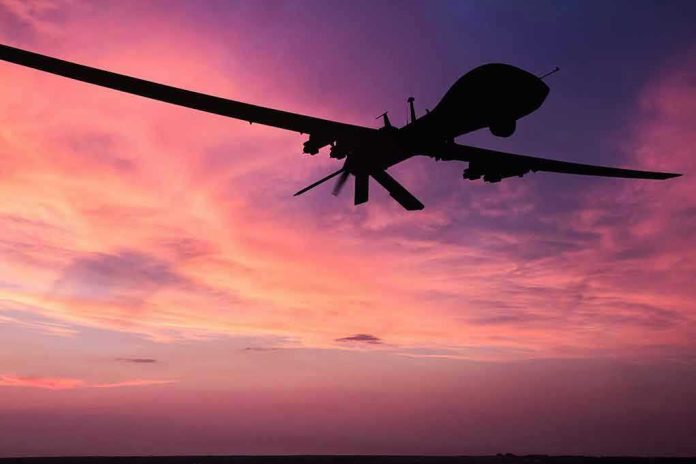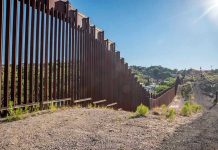
Texas schools are deploying remotely operated drones to confront active shooters within seconds, marking a dramatic shift in school security that challenges traditional approaches and raises new debates about privacy, deterrence, and constitutional rights.
Story Snapshot
- Texas-based Campus Guardian Angel launches non-lethal drone system to incapacitate school shooters in under 60 seconds.
- Florida and Texas districts begin installations following state-funded pilot programs and live demonstrations.
- System integrates with existing security infrastructure and is remotely piloted, emphasizing rapid response before law enforcement arrives.
- Supporters claim increased deterrence and safety; critics highlight concerns about surveillance, privacy, and long-term effectiveness.
Drone Technology Redefines School Security Response
Campus Guardian Angel, a Texas security technology company, has developed a drone system designed to rapidly confront and incapacitate active school shooters. The drones, stored on-site and piloted remotely, deploy pepper powder pellets within seconds of a silent alarm. According to the company, engagement with a shooter can begin within 15 seconds, aiming to neutralize threats in under a minute. This approach is intended to buy critical time for law enforcement to arrive, potentially saving lives during the most dangerous moments of an attack. The system integrates with school security cameras and digital twins for real-time situational awareness, setting a new standard in rapid, non-lethal intervention.
In March 2025, Campus Guardian Angel publicly launched the system, followed by live demonstrations in July at AcadeMir Preparatory High School in Miami-Dade, Florida, and other locations. Florida Governor Ron DeSantis approved $557,000 for pilot programs across three districts, and installations began in four Texas school districts and one university. School officials expressed strong support, citing increased confidence among students and parents. The system is positioned as a supplement to existing protocols, not a replacement for law enforcement, aiming to address the acknowledged gaps in traditional school safety measures such as resource officers and lockdown drills.
Stakeholders and Power Dynamics in School Safety Innovation
The primary stakeholders driving this initiative include Campus Guardian Angel, led by CEO Justin Marston, state education departments, local school administrators, and law enforcement agencies. Campus Guardian Angel is motivated by both commercial opportunity and a mission to save lives, while school districts seek effective, non-disruptive safety solutions. State governments, controlling funding and regulatory approval, are responding to constituent demands for robust security. Law enforcement sees value in technologies that can reduce risk and provide critical time during active shooter events. Schools serve as both customers and testbeds, and decision-makers include superintendents, boards, and state officials with final say over deployment and integration.
Power dynamics center on collaboration: Campus Guardian Angel depends on state and district buy-in, while local law enforcement and education departments influence operational policies. The pilot programs in Florida and Texas represent a political and public safety response to growing pressure for innovation, reflecting a broader shift toward technology-driven solutions in the face of persistent threats.
Impact, Debate, and Constitutional Considerations
Short-term effects include heightened deterrence and rapid response capability in pilot schools, with increased public awareness and debate about the role of technology in school safety. Long-term, successful pilot programs could lead to nationwide adoption and set new standards for school security, but questions remain about cost, privacy, and constitutional protections. The system costs approximately $1,000 per month for a 500-student school, suggesting scalability but raising concerns about surveillance and the normalization of high-security environments. Politically, the initiative may influence future policy and funding, especially as communities seek solutions that align with conservative values of protecting life and liberty without excessive government overreach. Supporters see the technology as a necessary evolution, while critics worry about overreliance on machines and potential unintended consequences. Legal scholars highlight the need to balance rapid response with privacy, liability, and use-of-force standards.
Texas company creates drones to confront school shooters in seconds https://t.co/mrVUvTj4fo #FoxNews
— ToneDoctor (@AmpegBabyBass76) August 9, 2025
Industry experts emphasize the system’s potential to reduce casualties by acting before law enforcement arrives, but caution that technology alone cannot solve the underlying causes of school violence. School safety researchers advocate for comprehensive prevention—including mental health and threat assessment—while acknowledging the importance of tools that protect students and staff in the critical minutes of a crisis. As installations continue and pilot results emerge, the debate over the best way to defend America’s schools remains urgent, with constitutional rights, parental trust, and community safety at the forefront.
Sources:
Drones to Combat School Shootings (Campus Guardian Angel Press Article)
Campus Guardian Angel Official Site
Texas Company Demos Drone-Led School Shooting Response (Fox News)













